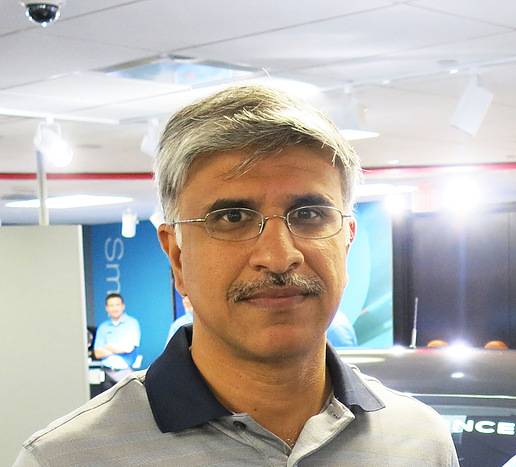 麦格纳的Swamy Kotagiri认为,与“创业公司”在创新技术方面展开合作有很多好处。
麦格纳的Swamy Kotagiri认为,与“创业公司”在创新技术方面展开合作有很多好处。
今年4月,SAE 2017全球汽车年会 将在美国底特律拉开帷幕。期间,麦格纳国际(Magna International)的首席技术官 Swamy Kotagiri将在“领导人峰会”圆桌讨论环节,探讨如何培养一种结构性创新公司文化。在麦格纳最近举办的年度创新大奖活动中,Kotagiri在其位于密歇根州特洛伊市的办公室中接受了《汽车工程国际(AEI)》的采访,分享了自己有关创新与颠覆的看法。
SAE:在创新文化中,我们似乎必须接受失败的可能性,是这样吗?
Kotagiri:对风险的可接受程度取决于你所处的研发阶段,如果已经在原型制造上花了大把的时间和金钱,那我就一定会开始狠抓规范,控制失败的可能性,这就是我界定风险高低的标准。按照我的理解,研发中70-80%的精力均应放在我们最擅长的领域,着重于从不同方面实现优化,剩余20-30%的精力才应用来尝试颠覆当今的现有技术或追求突破性进展。目前,我们公司有3到4个这样的项目。
SAE:内部创新研发、进行外部合作,又或者是直接收购一家创业公司,你们如何选择的?
Kotagiri:有很多种模式可供选择。首先,我们可以寻求领域内的知名研究机构或大学,与他们展开合作,大多是完成一些“基础科学”方面的研究。如果能够顺利通过这个阶段,我们通常会把项目拿回公司(麦格纳),然后进行应用程序方面的开发工作。
此外,我们还会进行一些特定应用技术的研发,比如半导体、光学成像系统、雷达、超声波雷达,甚至一些材料等。这类技术的研发通常需要整个联盟的参与,我们必须开发出一个适用于汽车领域的平台,这个平台对安全性和可靠性的要求通常会更加严格。这样一来,我们的合作伙伴将有机会进入市场,而我们则将有机会占领行业领先位置。
举例而言,某些材料能够感知温度,那我们可以把这种材料用作汽车座椅织物吗?3D打印技术的出现为加工领域创造了无穷的可能性,很多我们过去没法高效制造的零部件现在都可以直接打印。但我们并不需要拥有3D打印技术,而只要有3D打印机及其功能就可以了。我认为,这些合作并不是一种选择,而是一种“必须”。
SAE:“放出去”的决定会让您夜不能寐吗?
Kotagiri:这让我很感兴趣。我们认为创业公司反应非常灵敏。实际上,创业公司是将一批非常才华横溢的员工汇集在一个脱离大型组织架构的环境之下,然后以一种非常高效的方式工作,这就是关键。如果我们发现了一项有用的技术,那我们就可以与创业公司合作使用这种技术,但并不一定非要把这种技术拿过来为我所有。创业公司懂原理、懂技术,但却缺少汽车背景去预测行业在未来5年后的需求。当然,他们也没必要掺和进来,为设计一款满足2019年生产目标的原型而投入大量精力。很多创业企业并不这样想,但他们真的没必要浪费2年时间去搞一个什么假设。
与创业公司合作真的非常有用,方式也多种多样,比如进行直接投资、建立合作伙伴关系、形成合作联盟等,甚至有些公司也会随着时间的推移而成为麦格纳的一部分。有时候,我们也不想限制这些创业公司的发展,只让麦格纳独享他们的技术。
SAE:麦格纳是一家拥有颠覆性技术的公司吗?
Kotagiri:我们有一些工艺和产品都是市场同类中的首创,比如液压成型、座椅泡沫和Stow n’Go座椅概念等。对我们来说,最重要的是要保持开放的心态,迎接未来5到10年的各种可能性。此外,颠覆性并不仅仅体现在产品上,有时商业模型和交通运输的定义也可以很颠覆。我们必须充分理解这一点,并做好参与其中的准备。在我看来,先于其他所有人满足某种特定需求就是颠覆性的表现。
Swamy Kotagiri, Magna International’s Chief Technology Officer, will discuss how to foster an innovative organizational culture during a Leadership Summit roundtable, April 4 at the SAE WCX17 in Detroit. He spoke recently with Automotive Engineering on this topic at Magna’s Troy, MI, offices during the company's annual Innovation Awards activity.
Accepting the potential for failure seems inherent in an innovative culture, correct?
The acceptance for risk changes depending on what stages of R&D you are in. The rigor and discipline come after I have to spend a significant sum of money to make a prototype; that’s where I approach the threshold between low risk and higher risk. In my general terminology, 70-80% of it is more a step approach of what we know very well—optimizing the product in some way. The other 20-30% is disrupting something that exists today or making a quantum jump. I’d say we currently have three or four projects like that in corporate.
How do you choose between keeping innovation in house or partnering with an outsider—or maybe acquiring a start-up to do it?
There are various models we consider. One is, we can go to a research institute or university which is known in that field. We work with them on a defined package which usually is proving out the fundamental science. If we get past that phase, usually we bring it back in [to Magna] because then it’s application development.
Then there are certain technologies—semiconductors, optical imagers, radars, ultrasonics, even some materials—whose primary applications lie somewhere besides Automotive. In these it’s more of an alliance—we have to make such platforms applicable to Automotive regarding functional safety and reliability aspects that are usually far more stringent. This gives our partner a chance to enter a market and can offer us a chance to be first to market overall.
For example, certain materials can sense temperature—can I use them in a seat fabric? 3D printing has made a lot of things possible in tooling, making it extremely efficient to make a part which we couldn’t make before. We don’t have to own a piece of such enablers because we own the product and its functionality. I think these relationships are no longer a choice, but a ‘must’.
Do decisions to "go outside” keep you up at night?
It keeps me interested! But we believe the start-up ‘ecosystem’ is extremely agile and it gives an opportunity to get a group of really talented people to work in a system that is not driven by a large organization. That’s the key. So if we believe there is a technology that we need to drive, we’ll work with them [start-up] but we don’t necessarily need to own all of it. They bring the idea and fundamental science behind it, but they don’t have the automotive specification of what’s required five years from now. They don’t have to go through the ‘churn,’ come up with a prototype and hit a 2019 production target. A lot of start-ups can’t think that way. But they don’t have to waste two years of time working on an assumption, either.
It’s been really useful to work with start-ups—some are investments, some are partnerships, some are alliances and some are ‘scaled’ versions which over time become part of Magna. And we realize sometimes we don’t want to constrain them and make their technology exclusive to Magna.
Is Magna a disruptive-technology company?
We have processes and products—hydroforming, seat foams, the Stow n’ Go seating concept—that have been game-changers and first-to-market in automotive. The most important thing for us is to keep an open mind about what could happen in the next 5 to 10 years. There are disruptions that will come not only in product—some could also be business models about how mobility will be defined. We have to understand it and be ready to participate in it. Filling a need before anybody else does is, to me, being disruptive.
Author: Lindsay Brooke
Source: SAE Automotive Engineering Magazine
等级
打分
- 2分
- 4分
- 6分
- 8分
- 10分
平均分
- 作者:Lindsay Brooke
- 行业:汽车
- 主题:零部件
